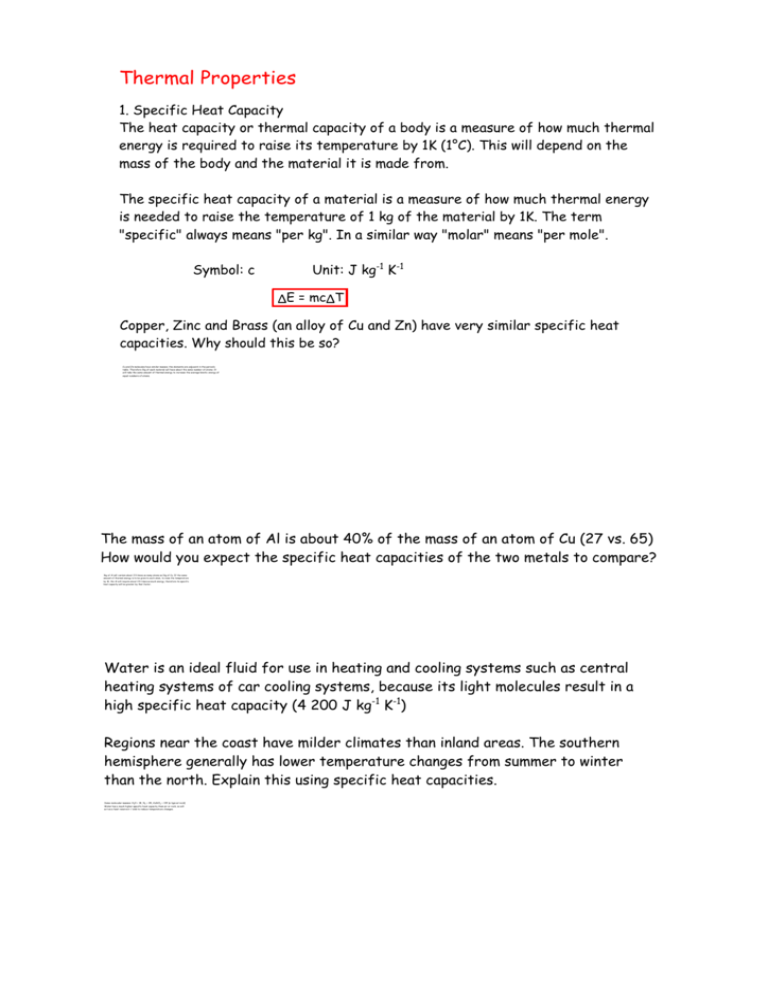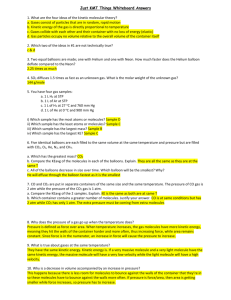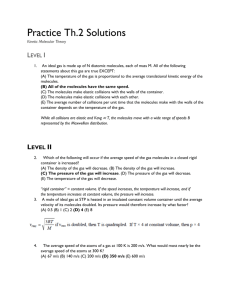3-2 Thermal Properties
advertisement

Thermal Properties 1. Specific Heat Capacity The heat capacity or thermal capacity of a body is a measure of how much thermal energy is required to raise its temperature by 1K (1°C). This will depend on the mass of the body and the material it is made from. The specific heat capacity of a material is a measure of how much thermal energy is needed to raise the temperature of 1 kg of the material by 1K. The term "specific" always means "per kg". In a similar way "molar" means "per mole". Symbol: c Unit: J kg-1 K-1 ΔE = mcΔT Copper, Zinc and Brass (an alloy of Cu and Zn) have very similar specific heat capacities. Why should this be so? Cu and Zn molecules have similar masses; the elements are adjacent in the periodic table. Therefore 1kg of each material will have about the same number of atoms. It will take the same amount of thermal energy to increase the average kinetic energy of equal numbers of atoms. The mass of an atom of Al is about 40% of the mass of an atom of Cu (27 vs. 65) How would you expect the specific heat capacities of the two metals to compare? 1kg of Al will contain about 2.5 times as many atoms as 1kg of Cu. If the same amount of thermal energy is to be given to each atom, to raise the temperature by 1K, the Al will require about 2.5 times as much energy, therefore its specific heat capacity will be greater by that factor. Water is an ideal fluid for use in heating and cooling systems such as central heating systems of car cooling systems, because its light molecules result in a high specific heat capacity (4 200 J kg-1 K-1) Regions near the coast have milder climates than inland areas. The southern hemisphere generally has lower temperature changes from summer to winter than the north. Explain this using specific heat capacities. Some molecular masses: H20 = 18, N2 = 28, CaSiO3 = 119 (a typical rock) Water has a much higher specific heat capacity than air or rock, so will act as a heat reservoir / sink to reduce temperature changes. Example 1 A 500g block of metal is heated by a 12V, 5A heater for 1 minute. As a result the average temperature of the metal rises by 12°C. What is the specific heat capacity of the metal? Example 2 A 25g piece of metal is heated in boiling water, before being transferred to an insulated container holding 100 mL of water at 20°C. The temperature of the water rises by 2°C. What is the specific heat capacity of the metal? Example 3 A 3kg iron horseshoe is at a temperature of 300°C when it is plunged into a tub containing 100L of water at 15°C. How much will the horseshoe heat the water? (c = 450 J kg-1 K-1 for iron.) 3. The 3 Phases (States) of Matter The particles of a material have kinetic energy because of their motion. Three types of motion are possible: rotation, vibration and translation (liquids and gases only). They also have potential energy because of their position in relation to the attractive forces of their neighbours: * In a solid, the particles are held in fixed positions - lowest energy * In a liquid, the particles are still held together, but not in fixed positions - a higher level of potential energy. * In a gas the particles have no effective attraction for each other. A change of temperature involves a change of kinetic energy; a change of state involves a change of potential energy. During a change of state (boiling a liquid, for example) the thermal energy being added increases the potential energy of the particles, not their kinetic energy. Therefore there is no temperature change. There will be a redistribution of kinetic energy from vibrational to translational, but the total does not change. 6. Evaporation The temperature of a liquid reflects the average kinetic energy of the molecules. However every molecule does not have exactly the same amount of energy. It is being transferred continually through collisions between the liquid molecules and also the molecules of the container walls and air above. As the temperature rises, not only does the average kinetic energy, but also the range of kinetic energies and speeds of the molecules. At the surface of the liquid a molecule is only attracted by its neighbours from below and to the sides, not from above. A molecule moving faster than the average may therefore be able to escape from the bulk of the liquid. This is evaporation and can happen at any temperature. * As a result, the average K.E. of the liquid molecules drops until heat is absorbed from the surroundings. * As the temperature rises, more molecules have enough energy to escape from the surface and the rate of evaporation rises * At the boiling point, the average KE is enough for vaporization and bubbles of vapour can form throughout the liquid, not just at the surface Factors that affect the rate of evaporation of a liquid are: * temperature (how close to the b.p.) * temperature of the surroundings (improves heat replacement) * surface area (evaporation only happens at the surface) * pressure (low pressure reduces the boiling point and eases entry into the gas phase) * air movement (removing the water molecules from above the surface) An advertisement for clothes driers used to say "Sunshine, a gentle breeze - ideal natural washday conditions!" Which of these factors is the ad referring to? 4. (Specific) Latent Heat The specific latent heat of a material is the amount of thermal energy required to convert 1kg of the material from one phase to another without any temperature change. Lf = Specific Latent Heat of Fusion (melting) Lv = Specific Latent Heat of Vaporization (boiling) Unit: J kg-1 ΔE = mLf or ΔE = mLv Problems: The cutout switch on a 650 W electric kettle fails and it continues to boil for 5 minutes before it is noticed. How much water will be converted to steam during this time? (Lv = 2.268 MJ kg-1) How much energy is needed to melt a 20 g ice cube at 0 ℃? (Lf = 334 kJ kg-1) 100g of water at 20 ℃ are placed in the freezer and converted to ice cubes at -10 ℃. How much energy must be removed in the process? (c for ice = 2100 J kg-1 K-1) Kinetic Model of an Ideal Gas The kinetic molecular theory is essentially part of the atomic theory. In an ideal gas, the temperature is a measure of the average kinetic energy of the molecules. The internal pressure is a result of collisions between the molecules. Pressure on the container walls also arises from collisions of the molecules of gas with the walls of the container. A molecule approaches the wall of the container, hits the wall and bounces off. During the collision, the molecule exerts a force on the wall and the wall exerts a force on the molecule. This results in a change in the momentum of the molecule (F = Δmv / Δt) and a pressure on the wall (P = F / A) Explain these observations in terms of the Kinetic Model When the volume of a gas is reduced at a constant temperature, the pressure rises. If the volume of the container is reduced, the frequency of collisions between the molecules and with the container walls will increase, since the average distance between them is reduced, but the average speed remains the same. i.e. the pressure will increase. When a fixed mass of gas at constant pressure is heated, it expands. Imagine a container with a floating lid. As the temperature rises, the average speed of the molecules increases. Collisions push the molecules further apart and the lid of the container upwards, keeping the internal pressure the same as the outside pressure. When a fixed mass of gas with constant volume is heated, the pressure rises. As the temperature rises, the average speed of the molecules increases. Collisions between molecules, and with the container walls increase in both force and frequency, resulting in an increase in pressure.







